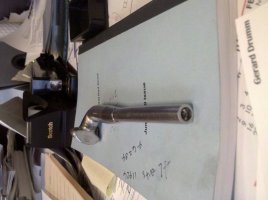Greg Ross
Not the newest member
LAYLA II is heading into I believe her 25 th year. I've expended quiite a bit of effort in progressively doing her, we'll call it her Mid-Life Refit" To my knowledge her standing rigging has never been replaced. I guess my aim in this discussion to to consider cable condition as a factor of time, or use and/ or service.
I never had the opportunity or pleasure to meet the former owner of "Dina G" a Mr. Gattuzo (in truth I think she's on her third name) From what the Widow shared with me, their "Dina G" spent her summers in downtown Philladelphia, never out to open Atlantic waters but perhaps a week or ten days on mainly a motoring excursion over the the Chesepeake most summers. Otherwise life as a cottage, dockside, Philly.
I would gather his ownership was from 1990 thru 2005, when then I bought the boat and relocated her to The Maritime Provinces. My use since buying her, at least up to this date has been relatively similar, day sails and at best two weeks a summer out cruising.
That standing rigging has obviously seen far more fresh water rain then salt spray. No broken strands, no discoloration of the fittings or cable and all the swedges look perfect every year.
Longer range I want to take this boat cruising, replacement of the standing rigging is something that should be done and the intent is to do so while I can afford it, but I've had a side bar thought. I come from an industry where, for safety and reliability lifting gear, slings, shackles, etc are subjected to periodic load testing and re-certification. I know where there's a test bed that could handle the lengths of the stays, even possibly linking them a number of them end to end to reduce the number of pull tests needed. I don't yet have a cost quote for having this performed but am inclined to think the relative cost vs expense for replacement of the entire rig would be relatively nominal. We're a "throwaway Society" does the rig really deserve the same fate?
Next related concern is the embedded chain plates, a drastic challenge to remove them for inspection/ replacement. Pehaps an apparatus can be designed to load test them as well.
Any thoughts?
I never had the opportunity or pleasure to meet the former owner of "Dina G" a Mr. Gattuzo (in truth I think she's on her third name) From what the Widow shared with me, their "Dina G" spent her summers in downtown Philladelphia, never out to open Atlantic waters but perhaps a week or ten days on mainly a motoring excursion over the the Chesepeake most summers. Otherwise life as a cottage, dockside, Philly.
I would gather his ownership was from 1990 thru 2005, when then I bought the boat and relocated her to The Maritime Provinces. My use since buying her, at least up to this date has been relatively similar, day sails and at best two weeks a summer out cruising.
That standing rigging has obviously seen far more fresh water rain then salt spray. No broken strands, no discoloration of the fittings or cable and all the swedges look perfect every year.
Longer range I want to take this boat cruising, replacement of the standing rigging is something that should be done and the intent is to do so while I can afford it, but I've had a side bar thought. I come from an industry where, for safety and reliability lifting gear, slings, shackles, etc are subjected to periodic load testing and re-certification. I know where there's a test bed that could handle the lengths of the stays, even possibly linking them a number of them end to end to reduce the number of pull tests needed. I don't yet have a cost quote for having this performed but am inclined to think the relative cost vs expense for replacement of the entire rig would be relatively nominal. We're a "throwaway Society" does the rig really deserve the same fate?
Next related concern is the embedded chain plates, a drastic challenge to remove them for inspection/ replacement. Pehaps an apparatus can be designed to load test them as well.
Any thoughts?

